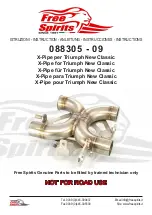
Manual, Collision Sensor,SR‑82
Document #9610‑60‑1007‑08
Pinnacle Park • 1031 Goodworth Drive • Apex, NC 27539 USA • Tel: 919.772.0115 • Fax: 919.772.8259 • www.ati‑ia.com
10
3.3 Pneumatic Connection
Compressed air is to be supplied to the port marked “P” in the range of 20 psi to 90 psi. This port accepts
#10‑32 or M5 pneumatic fittings. The pressure setting required for a particular application can be estimated
using the procedure outlined in
Section 3.3.1—Calculating Estimated Pressure Setting
The exact pressure
required must be determined through testing using the procedure outlined in
3.3.1 Calculating Estimated Pressure Setting
In order to determine the proper pressure setting for the collision sensor one must consider all
static and dynamic loads to which it is subjected. These include the loads produced due to the
static weight of the tooling, the inertial loads imposed by robot motion and the loads produced by
the end‑effector when performing its intended tasks. Once these loads are calculated, the nominal
pressure setting for the break‑away point can be determined. The calculation proceeds as follows:
3.3.1.1 Calculate Applied Loads
can be used to convert the forces acting on the end‑effector tooling into
the resulting moment, torque, and axial loads applied to the Collision Sensor. Use
the diagram shown in
and the formulas below to calculate the worst‑case
applied loads for your application. All (3) load cases—axial, torque, and moment—
should be assessed for their static, dynamic, and working force components.
NOTICE:
Not all of the component forces (static, dynamic, and working) are
present during all phases of the robot program. As a result, the worst case
conditions for axial, torque, and moment loads may occur at different times
in the program.










































